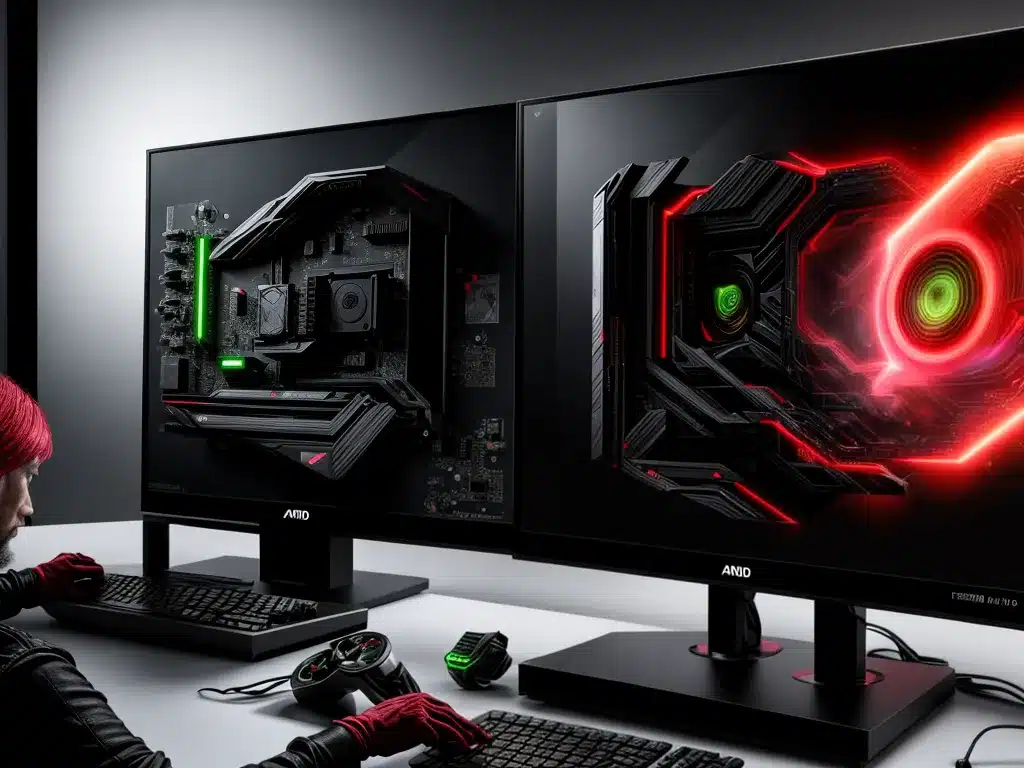Introduction
Super resolution technology is revolutionizing gaming by enabling higher resolution gaming on lower resolution displays. AMD and NVIDIA are the two main players in this space, with their respective FidelityFX Super Resolution (FSR) and Deep Learning Super Sampling (DLSS) solutions. In this article, I will compare AMD FSR and NVIDIA DLSS head-to-head to help you understand the key differences and similarities between these two competing super resolution technologies.
How Super Resolution Works
Super resolution is a technique that takes lower resolution images and upscales them to higher resolution images. This allows games to render at lower resolutions, which improves performance, while the upscaled image sharpens the visuals back to higher resolutions for display.
There are two main approaches used in super resolution for gaming:
-
Spatial upscaling – The image is upscaled using advanced interpolation and filtering techniques to reconstruct the finer details. No external data is used.
-
AI upscaling – The image is upscaled using an AI model trained on high resolution image pairs to add realistic detail. Requires external training data.
AMD FSR uses spatial upscaling while NVIDIA DLSS uses AI upscaling. Next, let’s look at both solutions in more depth.
AMD FidelityFX Super Resolution (FSR)
AMD launched FidelityFX Super Resolution (FSR) in June 2021. FSR uses advanced spatial upscaling algorithms to upscale lower resolution rendered frames to a higher display resolution.
Key features:
- Four quality modes – Ultra Quality, Quality, Balanced, Performance
- Leverages temporal data for better edge reconstruction
- Open source and cross-platform – works on AMD, NVIDIA and Intel GPUs
- Integrated into over 150+ games
FSR is not as resource intensive as AI upscaling, though the image quality is lower. It works best in motion and can be easily integrated into games with minimal performance overhead.
NVIDIA Deep Learning Super Sampling (DLSS)
NVIDIA introduced DLSS in 2018. DLSS uses the power of AI and deep learning to upscale lower resolution rendered frames to higher display resolutions.
Key features:
- Three quality modes – Quality, Balanced, Performance
- Powered by NVIDIA Tensor Cores and AI models
- Trained on high resolution game image datasets
- Integrated in over 200+ games
DLSS produces sharper image quality compared to spatial upscaling methods like FSR, though it requires more GPU processing power. It also requires per-game training data.
AMD FSR vs. NVIDIA DLSS: Comparison
| | AMD FSR | NVIDIA DLSS |
|-|-|-|
| Technology | Spatial upscaling | AI upscaling |
| Image quality | Good | Superior to FSR |
| Performance impact | Minimal | Requires GPU Tensor Cores |
| Supported GPUs | AMD, NVIDIA, Intel | NVIDIA RTX cards only |
| Game integration difficulty | Easy | Requires training data |
| Sharpness and artifacts | Slightly softer, minimal artifacts | Sharper, minimal artifacts |
In summary, DLSS produces superior image quality compared to FSR, but requires more GPU horsepower and per-game training data. FSR has lower quality but is open, easy to integrate, and has minimal performance impact.
Real-World Performance
In practice, both FSR and DLSS can provide significant performance gains over native resolution rendering.
For example, testing in God of War shows FSR Balanced mode provides a 77% performance boost over native 4K, while DLSS Balanced mode provides a 105% performance increase. However, DLSS delivers higher image quality over FSR in this game.
The performance benefits you get will vary based on the game, specific settings, and GPU hardware. Both technologies allow more GPU headroom to turn on higher graphics settings and still hit smooth frame rates.
Developer Adoption
AMD FSR adoption is growing quickly given its open nature and ease of integration. Over 150 games and engines support FSR as of February 2023. Major adopters includeGod of War, Death Stranding, Microsoft Flight Simulator, and Crysis Remastered.
Comparatively, NVIDIA DLSS is limited to RTX cards and requires training data, but is present in over 200 games. Major titles with DLSS include Cyberpunk 2077, Marvel’s Spiderman, Red Dead Redemption 2, and Call of Duty.
NVIDIA also collaborates closely with developers to train and implement DLSS, while AMD allows FSR to be integrated via open source plugins.
The Verdict
In conclusion, NVIDIA DLSS delivers superior image quality to AMD FSR, but requires more GPU power and per-game training data. FSR is open and easier to integrate into games, providing a good “good enough” option accessible to all gamers, even on lower end hardware.
For NVIDIA users, DLSS is a clear winner if available in the games you play. For AMD users, FSR provides an excellent balance of performance and image quality enhancement. Ultimately both technologies are impressive and push super resolution into the mainstream. I’m excited to see how game developers continue optimizing implementations of FSR and DLSS in the future.













